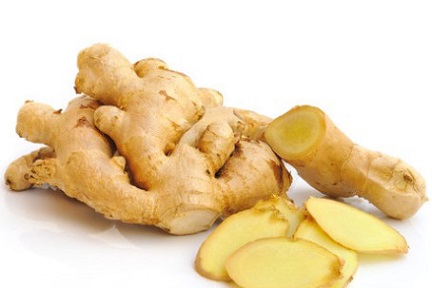Herbs And Phytochemicals: Study Shows That Zingerone And Shogoal From Ginger Can Inhibit SARS-CoV-2
Nikhil Prasad Fact checked by:Thailand Medical News Team Apr 18, 2024 1 year, 1 week, 2 hours, 18 minutes ago
Herbs And Phytochemicals: The global health landscape has witnessed a paradigm shift towards natural remedies in combating various diseases, particularly viral infections. The ongoing COVID-19 pandemic has highlighted the need for effective treatments derived from botanical sources. Among these natural compounds, ginger, with its rich array of bioactive components, has garnered significant attention for its potential in inhibiting SARS-CoV-2, the virus responsible for COVID-19.
 Zingerone And Shogoal From Ginger Can Inhibit SARS-CoV-2
Unlocking Ginger's Bioactive Arsenal
Zingerone And Shogoal From Ginger Can Inhibit SARS-CoV-2
Unlocking Ginger's Bioactive Arsenal
Ginger (Zingiber officinale), a well-known herbal plant, contains a myriad of bioactive compounds that contribute to its therapeutic properties. Notably, zingerone and shogaol, derived from gingerols, have emerged as key players in the realm of natural medicine. Zingerone, a major flavor component in ginger, exhibits antioxidant, anti-inflammatory, and immunomodulatory effects. Its multifaceted pharmacological profile positions it as a promising candidate for antiviral interventions. Shogaols, produced through the dehydration of gingerols, share similar properties and have been studied for their potential in combating various diseases, including cancer.
The Urgent Need for SARS-CoV-2 Inhibitors
The emergence of SARS-CoV-2 and the subsequent COVID-19 pandemic have underscored the critical need for effective antiviral agents. The spike (S) protein of SARS-CoV-2 plays a pivotal role in viral entry and replication, making it a prime target for therapeutic interventions. Inhibiting the interaction between the viral spike protein and host cell receptors is a key strategy in mitigating viral infectivity and spread.
Computational Insights: Evaluating Zingerone and Shogaol as Inhibitors
In a recent
Herbs And Phytochemicals study conducted by researchers from Iraq, computational tools were employed to investigate the inhibitory potential of zingerone and shogaol against SARS-CoV-2. Utilizing advanced software such as Gaussian 09, UCA FUKUI, MGL implement, DSV, and LigPlus, the researchers delved into the molecular interactions between these natural compounds and the viral spike proteins.
Molecular Orbital Analysis: Unveiling Activity and Reactivity Patterns
The study employed molecular orbital analysis to elucidate the activity and reactivity patterns of zingerone and shogaol. Physical properties such as ELUMO (energy of the lowest unoccupied molecular orbital), energy gap, electronegativity, hardness, and dipole moment were assessed. These parameters provided insights into the compounds' electronic structure, which in turn influenced their potential as inhibitors.
The Fukui function and Dual Descriptor were instrumental in identifying the most active sites within zingerone and shogaol molecules. These computational techniques allowed researchers to predict the electron-accepting and electron-donating capabilities of specific atoms within the compounds, shedding light on their potential mechanis
ms of action against SARS-CoV-2.
Interacting with Viral Spikes: Mechanistic Insights into Inhibition
Docking simulations were conducted to explore how zingerone and shogaol interacted with the viral spike proteins. The simulations revealed that zingerone and shogoal targeted key regions on the spike proteins, hindering the virus's ability to bind to host cell receptors. The binding energies calculated during the docking process provided quantitative measures of the strength of these interactions, with lower binding energies indicating stronger affinity and potential inhibitory activity.
Molecular Dynamics: Unraveling the Bonding Patterns
Detailed analyses of the interactions between zingerone, shogaol, and the amino acids comprising the viral spike proteins provided further insights into the mechanisms of inhibition. Hydrogen bonding, alkyl interactions, and pi-alkyl interactions were identified as critical mechanisms through which these compounds exerted their inhibitory effects. The specificity of these interactions highlighted the potential of zingerone and shogaol to disrupt essential viral processes and prevent viral entry and replication.
Conclusion: Harnessing Ginger's Power Against COVID-19
In conclusion, the study underscored the potential of zingerone and shogaol from ginger as inhibitors of SARS-CoV-2. Their ability to interact with viral spike proteins and disrupt key binding processes signifies a promising avenue for developing novel antiviral therapies. Further experimental validation, including in vitro and in vivo studies, is essential to leverage the full therapeutic potential of these natural compounds in combating COVID-19 and other viral infections. The findings of this study contribute to the growing body of evidence supporting the use of natural remedies in the fight against emerging viral threats.
The study findings were published in the peer reviewed journal: Parasite Epidemiology and Control (Elsevier).
https://www.sciencedirect.com/science/article/pii/S2405673124000114
Thailand Medical News would like to add that many stupid and ignorant factcheckers and certain factcheckers that were paid by those pushing the mRNA COVID-19 vaccine narrative had in the past claimed that articles extolling the benefits of ginger in possibly protecting against COVID-19 as fake news or misinformation despite themselves not providing any scientific evidence that it could not do so. To date, a number of studies have should the effects of ginger and its phytochemicals in inhibiting SARS-CoV-2. We suggest people take necessary actions against many of these so-called fraudulent fact-checkers in any way they can!
For the latest on
Herbs And Phytochemicals, keep on logging to Thailand Medical News.
